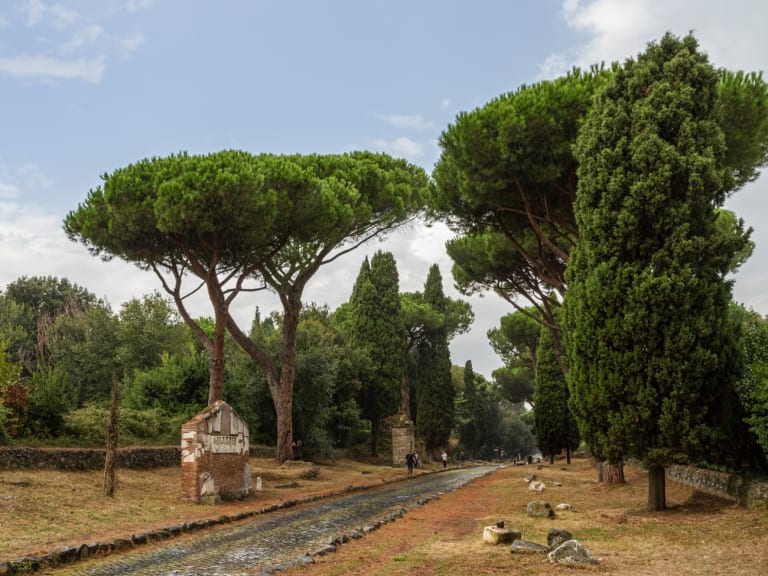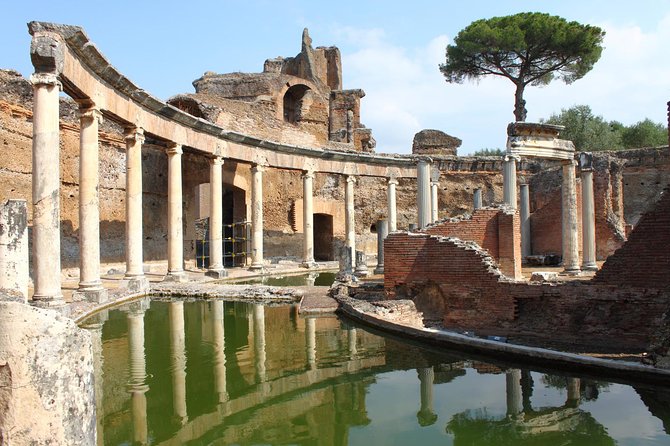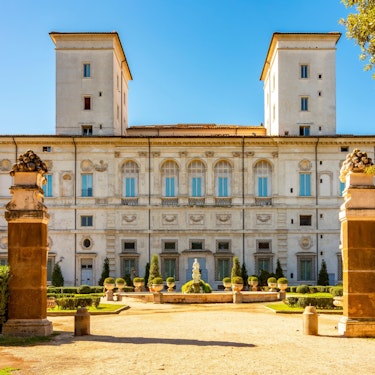More about: Via Appia Tours in Rome
The Appian Way in Rome is estimated to be around 2,300 years old. It was laid out in 318 BC by the Roman consul Appius Claudius Blindus, in order to connect Rome with Capua. Later, it was extended to the present-day city of Brindisi and from there Rome was connected via the Appian Way to Greece, Egypt and the East, facilitating military and commercial expeditions.
Today, Rome's Appian Way can be explored on foot or by bicycle. It is a wonderful, leisurely ride with many stories to tell. It is a journey to be taken at a leisurely pace, admiring the landscapes and monuments that you will discover along the sides of the Appian Way. There are many things to see and do in Rome and walking the Appian Way on a tour is one of the best.
What are the guided tours of the Appian Way in Rome like?

There are several options for guided tours of Rome's Appian Way and it really is well worth taking a guided tour. You can choose to do the tour on foot or by bicycle. Bicycle tours can be private or group tours and are usually on electric bicycles.
You can opt for regular bikes, but keep in mind that it is a long way and you have to be used to cycling to tolerate such a long trip.
Prices range from 50 to 95 euros depending on the length of the tour and whether it is a private or group tour. These tours last between 4 and 5 hours and include insurance (you should check what coverage is available).
You also have the possibility of choosing a tour that, in addition to the Appian Way, includes other attractions. In this case you can opt for one by car, with guide, driver and private driver for approximately 170 euros.
The advantage of these tours is that the entrance fees are usually included in the price and they are preferential and you don't have to queue. By avoiding queues you gain a lot of time to enjoy the activities. This is undoubtedly one of the best tours in Rome.
The start of Rome's Appian Way tour at Porta San Sebastiano

The start of the Appian Way tour begins at the Porta San Sebastiano in Rome. Also known as the Appian Gate, it is the largest of the structures that form part of the Aurelian Walls.
Fortunately it is in an excellent state of preservation. Nowadays, the Gates of San Sebastiano house the Museum of the Walls, which is well worth a visit.
The museum is divided into 3 sections: ancient, medieval and modern, showing the different stages of the fortifications of the city in an interactive and didactic way.
If you are particularly interested in architecture, you will really enjoy this museum, because it is very well structured and the information visitors receive and the educational aids available are very good.
From here, the tour continues along Rome's Appian Way until you reach the second point of interest, the Quo Vadis Church.
The Domine Quo Vadis Church on the Appian Way in Rome

Following the route of the Appian Way in Rome, you will reach the Domine Quo Vadis Church. It is believed that in this church Jesus, now dead, appeared to Peter while he was trying to flee from the crucifixion. After this appearance, Peter would have returned to Rome to accept his martyrdom and die on the cross.
The Domine Quo Vadis Church was built in the 17th century from a small chapel dating from the 9th century and there are beautiful frescoes to admire inside.
The theme of the frescoes is the Crucifixion of Christ and the martyrdom of St. Peter. If you are a fan of religious tourism you can also visit the Sistine Chapel, one of the must-see sights in Rome.
After a short ride, you will reach the third point of the tour, the Catacombs of St. Callixtus.
The Catacombs of St. Callixtus on the Appian Way in Rome

Along Rome's Appian Way, you will find numerous tombs and catacombs because in ancient times it was forbidden to bury the dead within the city walls. One such burial site is the Catacombs of St. Callixtus which house more than 170,000 tombs.
The Catacombs of St. Callixtus are the best preserved of the entire Appian Way and can be visited.
It is a recommended visit, as there are numerous tombs of Christian martyrs and saints. If the cemeteries impress you, this activity is best skipped.
Bear in mind that both the Catacombs of St. Callixtus and the Catacombs of St. Sebastian are among the attractions that attract the most attention from tourists, so you'll want to book tickets well in advance to avoid disappointment - it's almost impossible to get tickets on the day.
The Basilica of St. Sebastian on Rome's Appian Way

A little further on from the Catacombs of St. Callixtus (San Callisto) is the Basilica of St. Sebastian. In this Basilica, there is also a huge complex of catacombs, which are accessed via a staircase in the right aisle of the Basilica.
The Catacombs of St. Sebastian became a Christian burial place at the end of the 2nd century AD. Previously they had already been used as a pagan cemetery.
Please note that to enter the Catacombs (those of St. Callixtus or St. Sebastian) there are entrance fees and queues can take hours. It is advisable to book your tickets to the Catacombs in advance.
Remember that there are skip-the-line tickets available. They are slightly more expensive, but it is worth the extra cost if you save hours of time by skipping the longest queues in Rome. If you are staying longer in Rome, you can also visit the Vatican Catacombs.
About 200 metres ahead of the Catacombs of St. Sebastian, you will find the next stop, the ruins of Villa di Massenzio.
The Ruins of the Villa di Massenzio on the Appian Way in Rome

The ruins of the Villa di Massenzio on the Appian Way in Rome consist of three main buildings: the circus, the palace and the mausoleum. It is a very interesting architectural complex worth visiting.
The dynastic mausoleum is also known as the tomb of Romulus, because it is believed that he was buried there. Whether the story of Romulus' burial here is true or not, it is a magnificent monument and together with the other two buildings it forms a harmonious complex of sober and timeless beauty.
Immediately after passing the tomb of Romulus, you will come to the sixth stop on the Appian Way tour of Rome, the Mausoleum of Cecilia Metella.
The Mausoleum of Cecilia Metella on Rome's Appian Way

When you reach this point, you will see one of the most emblematic mausoleums of Roman times. The Mausoleum of Cecilia Metella is one of the most impressive funerary centres in Rome. The huge and beautiful construction served as the tomb of Cecilia Metella, daughter of the consul Quintus Metellus, conqueror of Crete.
The Mausoleum of Cecilia Metella was incorporated into the castle by the Caetani family as the main tower and has maintained its imposing appearance to this day.
Continue walking and after a few minutes you will find, on your right, the seventh point of interest of the Appian Way of Rome, the ruins of the Frontespizio and a little further on the medieval farmhouse of Santa Maria Nova and the pyramidal sepulchre.
The ruins of the Frontespizio on Rome's Appian Way, the medieval farmhouse of Santa Maria Nova and the pyramidal sepulchre

These three monuments are within walking distance of each other, so it won't take you long to walk around them. The ruins of the Frontespizio are a small, well-preserved nucleus of ruins. They are thought to date back to about the 1st century BC. A few metres further on is the medieval farmhouse of Santa Maria Nova.
Continue walking for a few metres and you will see a pyramid-shaped structure ahead, of which there is not much information so far, but due to the large size of the tomb there has been much speculation about the owner, but none of the theories have been confirmed.
Continuing along Rome's Appian Way, about 100 metres further on, you will find the eighth stop, formed by the so-called Tumuli degli Orazi and 150 metres from the latter, you will see the Villa dei Quintili.
Tumuli degli Orazi and Villa dei Quintili on the Appian Way in Rome

The Tumuli degli Orazi burial complex consists of two tombs similar to the Etruscan tombs found in the necropolis of Banditaccia. Although many theories have been woven around these tombs, the only thing that has been corroborated so far is that one of them is empty and there are no certain indications as to who might have been buried there.
In contrast to the austerity of the Tumuli degli Orazi, you will find 150 metres further on, the Villa dei Quintili. It is a magnificent residential complex, the largest in the suburbs of Rome.
The Villa dei Quintili belonged to the Quintilio brothers, Roman consuls in 151 AD.
The brothers were murdered for alleged treason and conspiracy on the orders of Emperor Commodus and the Villa was confiscated. After the execution of the Quintili brothers, the Villa continued to be used as a residence by several Roman emperors, including Commodus.
Continuing the walk you will reach the ninth stop, the Casal Rotondo.
The Casal Rotondo

The Casal Rotondo is the largest circular mausoleum on the Appian Way in Rome and one of the largest in Europe. This huge mausoleum was once covered with travertine marble and is believed to have been built around the 1st century BC.
Unfortunately, despite many studies, not much more has been discovered about its construction, origins and original owners.
A long time ago, a fragmentary inscription with the name Cotta was found. This discovery has led archaeologist Luigi Canina to believe that it is a funerary monument erected by Messalino Cotta, son of the consul Messalla Corvinus, a lawyer and man of letters at the time of Augustus, but this theory has not been confirmed.
Whoever the owner was, there is no doubt that it is a magnificent monument and the Casal Rotondo is one of my favourite stops on Rome's Appian Way.
A few metres away is the tenth and last stop on Rome's Appian Way, the Selce Tower.
The Selce Tower

It is believed that in the 12th century the Astalli family used the foundations of an ancient Roman tomb as the basis for a huge tower known today as the Selce Tower. It is located on the Appian Way, almost at the end of the tourist route.
During the Middle Ages, Rome' s ancient monuments suffered great deterioration because they were used as quarries, providing people with cheap bricks and stone.
Over the centuries, the monuments along the Appian Way were successively plundered, losing most of their riches. The Selce Tower did not escape this fate and, in addition to the logical deterioration due to the passage of time, successive sackings have robbed it of the splendour it must have had in its day.
If you look in the distance you can see the aqueduct that supplied the Villa dei Quintili. The view is magnificent, an extraordinary work of engineering and an extraordinary beauty.
Is it possible to walk the Appian Way with children?

Walking the Appian Way in Rome is a wonderful experience, but it means many hours of walking. Walking that far with small children is not recommended if they are not used to it. If you want to do it, take a pram with you so that you can help the little ones when they are too tired.
Don't forget to bring water and snacks for the little ones. Don't forget hats and sunscreen either.
Walking the Appian Way with children can be easier outside of the warmer and colder months. If you are travelling to Rome with children, consider the weather when planning your trip, try to plan it during the best time to travel to Rome.
Tips for a tour of Rome's Appian Way

- As it's a time-consuming tour, remember to stay hydrated (bring a few bottles of water with you), wear comfortable clothes (sportswear is even better) and appropriate footwear (avoid sandals and don't even think about wearing heels).
- The best thing to do is to book tickets for the Via Appia attractions you want to enter to save time during your trip and make sure you have tickets available - always opt for priority tickets, queuing in Rome can be really tedious.
- Plan your trip well in advance and make sure you book your tickets to at least the main attractions well in advance.
- If this is your first trip to Rome, try to prepare your itinerary well in advance in case of unforeseen events. The key to a successful trip is planning ahead.
- Keep in mind these 10 tips for organising your trip to Rome and you'll save a lot of time organising your visit.














